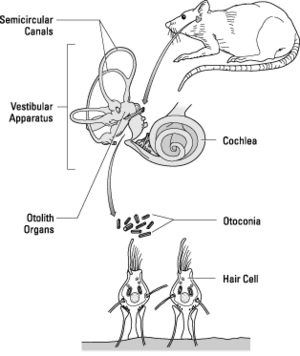STS-65 facts for kids
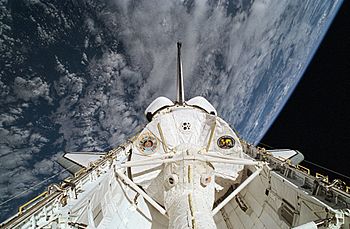
The Spacelab Module LM1 inside the Space Shuttle Columbia, used for the International Microgravity Laboratory
|
|
| Mission type | Microgravity research |
|---|---|
| Operator | NASA |
| Mission duration | 14 days, 17 hours, 55 minutes |
| Distance travelled | 9,886,200 kilometers (6,143,000 mi) |
| Orbits completed | 235 |
| Spacecraft properties | |
| Spacecraft | Space Shuttle Columbia |
| Payload mass | 10,811 kilograms (23,834 lb) |
| Crew | |
| Crew size | 7 |
| Members |
|
| Start of mission | |
| Launch date | 8 July 1994, 16:43:01 UTC |
| Launch site | Kennedy LC-39A |
| End of mission | |
| Landing date | 23 July 1994, 10:38:01 UTC |
| Landing site | Kennedy SLF Runway 33 |
| Orbital parameters | |
| Reference system | Geocentric |
| Regime | Low Earth |
| Perigee | 300 kilometres (190 mi) |
| Apogee | 304 kilometres (189 mi) |
| Inclination | 28.45 degrees |
| Period | 90.5 minutes |
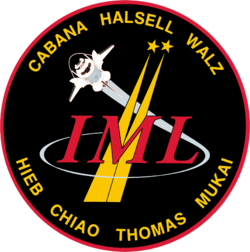 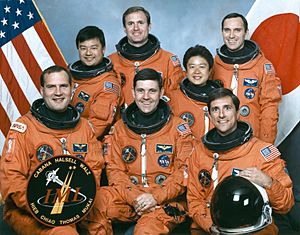 Left to right - Seated: Hieb, Cabana, Thomas; Standing: Chiao, Halsell, Naito-Mukai, Walz |
|
STS-65 was a Space Shuttle mission using the orbiter Columbia. It launched from Kennedy Space Center, Florida, on July 8, 1994. The main goal of this mission was to study how things behave in microgravity, which is a very weak gravity environment. This mission was part of the Space Shuttle program.
The commander of STS-65 was Robert D. Cabana. He later became the director of the Kennedy Space Center.
Contents
Meet the Astronauts: The STS-65 Crew
The STS-65 mission had a crew of seven astronauts. They were all important for carrying out the many science experiments.
| Position | Astronaut | |
|---|---|---|
| Commander | Robert D. Cabana Third spaceflight |
|
| Pilot | James D. Halsell First spaceflight |
|
| Mission Specialist 1 | Richard J. Hieb Third and last spaceflight |
|
| Mission Specialist 2 | Carl E. Walz Second spaceflight |
|
| Mission Specialist 3 | Leroy Chiao First spaceflight |
|
| Mission Specialist 4 | Donald A. Thomas First spaceflight |
|
| Payload Specialist 1 | Chiaki Mukai, NASDA First spaceflight |
|
One of the crew members was Chiaki Mukai. She was the first Japanese woman to travel into space.
Mission Goals: Studying Life in Space
The STS-65 mission carried the International Microgravity Laboratory (IML-2). This was the second time a Spacelab module was used to do research in microgravity. Microgravity means a very low gravity environment, like what astronauts experience in orbit.
The IML-2 mission was a big international effort. Scientists from many countries worked together. These included the European Space Agency (ESA), Canada, France, Germany, and Japan. They partnered with NASA to provide experiments for the mission.
The main focus of IML-2 was on two areas:
- Microgravity science: This involved understanding how materials behave without strong gravity. Scientists hoped to create new materials that are hard to make on Earth.
- Life sciences: This looked at how living things, like cells and organisms, are affected by space. It also helped understand health issues for astronauts in space.
The experiments used special equipment inside the Spacelab module. This equipment allowed scientists to study different aspects of life and materials in space.
Life Science Experiments: Animals and Plants
The STS-65 mission included several important life science experiments. These studies helped scientists learn how living things adapt to space.
Newt Experiment: How Gravity-Sensing Organs Develop
One experiment studied Japanese Red-Bellied Newts. Scientists wanted to see how their gravity-sensing organs developed in space. These organs are in the inner ear of animals. They contain tiny calcium carbonate stones called otoliths. On Earth, gravity pulls on these stones, sending signals to the brain about balance.
The experiment aimed to find out if growing up in microgravity would change how these otoliths form. It also looked at how the cells and nerves connected to them would develop.
Jellyfish Experiment: Behavior and Development in Space
Another experiment focused on Moon Jellyfish (Aurelia aurita). Researchers observed how jellyfish behaved and developed in space. They watched how they swam and moved. They also studied how their gravity-sensing organs formed.
A key part of this experiment was to see if a small amount of artificial gravity could help prevent any negative effects of space travel on the jellyfish.
Daylily Experiment: Plant Growth in Microgravity
The PEMBSIS experiment studied daylily cells. Scientists wanted to know if spaceflight changed how daylily embryos grew. They also checked if cell division and chromosomes were affected by the space environment.
Life Science Equipment and Organisms
Organisms Studied
- Newts: Both adult and young Japanese Red-Bellied Newts (Cynopus pyrrhogaster) were used. Young newts were chosen because their balance system develops during the mission time. Adults could lay eggs in space, allowing scientists to study embryos that grew in microgravity.
- Jellyfish: Moon Jellyfish (Aurelia aurita) were the subjects. Both the stationary polyp stage and the free-swimming ephyra stage were studied.
- Daylilies: The PEMBSIS experiment used daylily cells (Hemerocallis cv. Autumn Blaze).
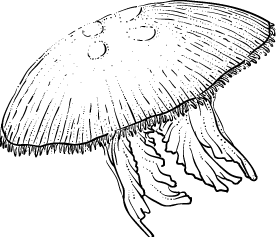
Special Hardware Used
To keep the organisms safe and allow for experiments, special equipment was used:
- Aquatic Animal Experiment Unit (AAEU): This unit, from Japan's space agency (NASDA), housed the newts. It kept them alive in water for over 19 days.
- Nizemi: This German-made microscope and camera system could rotate slowly. It allowed scientists to watch jellyfish behavior at different levels of gravity.
- Biorack: The European Space Agency's Biorack facility held the jellyfish.
- Refrigerator/Incubator Module (R/IM): This unit kept samples at controlled temperatures, either cool or warm.
- Plant Fixation Chambers (PFCs): These sealed containers held the daylily cells. They allowed scientists to add chemicals in space to "fix" the plant cells for later study.
Mission Operations: What Happened During the Flight
Before Launch
- Daylily cell cultures were prepared about a week before the mission.
- Newt eggs and adult newts were loaded into their water tanks about 36 hours before launch.
- Jellyfish polyps were given a special solution to make them change into the ephyra form 24 hours before launch.
- All these setups had matching "ground controls" on Earth. This allowed scientists to compare what happened in space to what happened on Earth.
During the Flight
- Astronauts regularly checked on the newt eggs and adults. Sadly, two adult newts died during the mission.
- Jellyfish were videotaped using the rotating microscope to see how they swam in different gravity levels. Some jellyfish were preserved in space for later study.
- Some daylily cell cultures were also preserved in space using a chemical solution.
After Landing
- The newts were recovered about six hours after landing. Some larvae were preserved, and others were studied to see how space affected their balance.
- Living jellyfish were counted, photographed, and studied for their pulse rate and body parts.
- Daylily cells were also photographed and preserved shortly after landing to check for changes in their cells and chromosomes.
Mission Results: What Scientists Learned
Newt Study Findings
The newt larvae that grew up in space developed at the same speed as those on Earth. However, the space-reared larvae had larger endolymphatic sacs (part of the inner ear) and more otoconia (the tiny stones) inside them. The otoconia also appeared much faster in the newts that grew in microgravity.
Jellyfish Study Findings
Jellyfish that developed in microgravity had more abnormal arm numbers compared to those that developed on Earth. Also, fewer of the space-grown jellyfish swam normally after landing. Interestingly, jellyfish polyps that budded (a type of reproduction) in space produced more buds and developed faster than those on Earth. This suggests that while development generally went well, some jellyfish were more sensitive to microgravity.
Daylily Cell Study Findings
Scientists found changes in the cells and chromosomes of daylily cells that were in space. Many cells from the space samples had two nuclei (binucleate cells), while all the control cells on Earth had only one nucleus.
Newts in Space
During the mission, two of the four adult newts died. The first death was thought to be due to stress. The second newt was found by astronaut Donald A. Thomas on July 17, 1994. This second death was called "peculiar" by a scientist on the ground. It was difficult to remove the dead newt from the tank because of weightlessness. The newts were Japanese Red-bellied Newts (Cynops pyrrhogaster).
Images for kids



